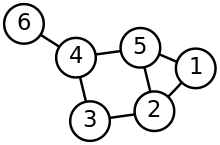
Back رأس (نظرية البيان) Arabic Vèrtex (teoria de grafs) Catalan Vrchol (graf) Czech Knoten (Graphentheorie) German Vertico (grafeoteorio) Esperanto Vértice (teoría de grafos) Spanish Erpin (grafo teoria) Basque رأس (نظریه گراف) Persian Solmu (verkko) Finnish Sommet (théorie des graphes) French
This article includes a list of general references, but it lacks sufficient corresponding inline citations. (February 2014) |

In discrete mathematics, and more specifically in graph theory, a vertex (plural vertices) or node is the fundamental unit of which graphs are formed: an undirected graph consists of a set of vertices and a set of edges (unordered pairs of vertices), while a directed graph consists of a set of vertices and a set of arcs (ordered pairs of vertices). In a diagram of a graph, a vertex is usually represented by a circle with a label, and an edge is represented by a line or arrow extending from one vertex to another.
From the point of view of graph theory, vertices are treated as featureless and indivisible objects, although they may have additional structure depending on the application from which the graph arises; for instance, a semantic network is a graph in which the vertices represent concepts or classes of objects.
The two vertices forming an edge are said to be the endpoints of this edge, and the edge is said to be incident to the vertices. A vertex w is said to be adjacent to another vertex v if the graph contains an edge (v,w). The neighborhood of a vertex v is an induced subgraph of the graph, formed by all vertices adjacent to v.